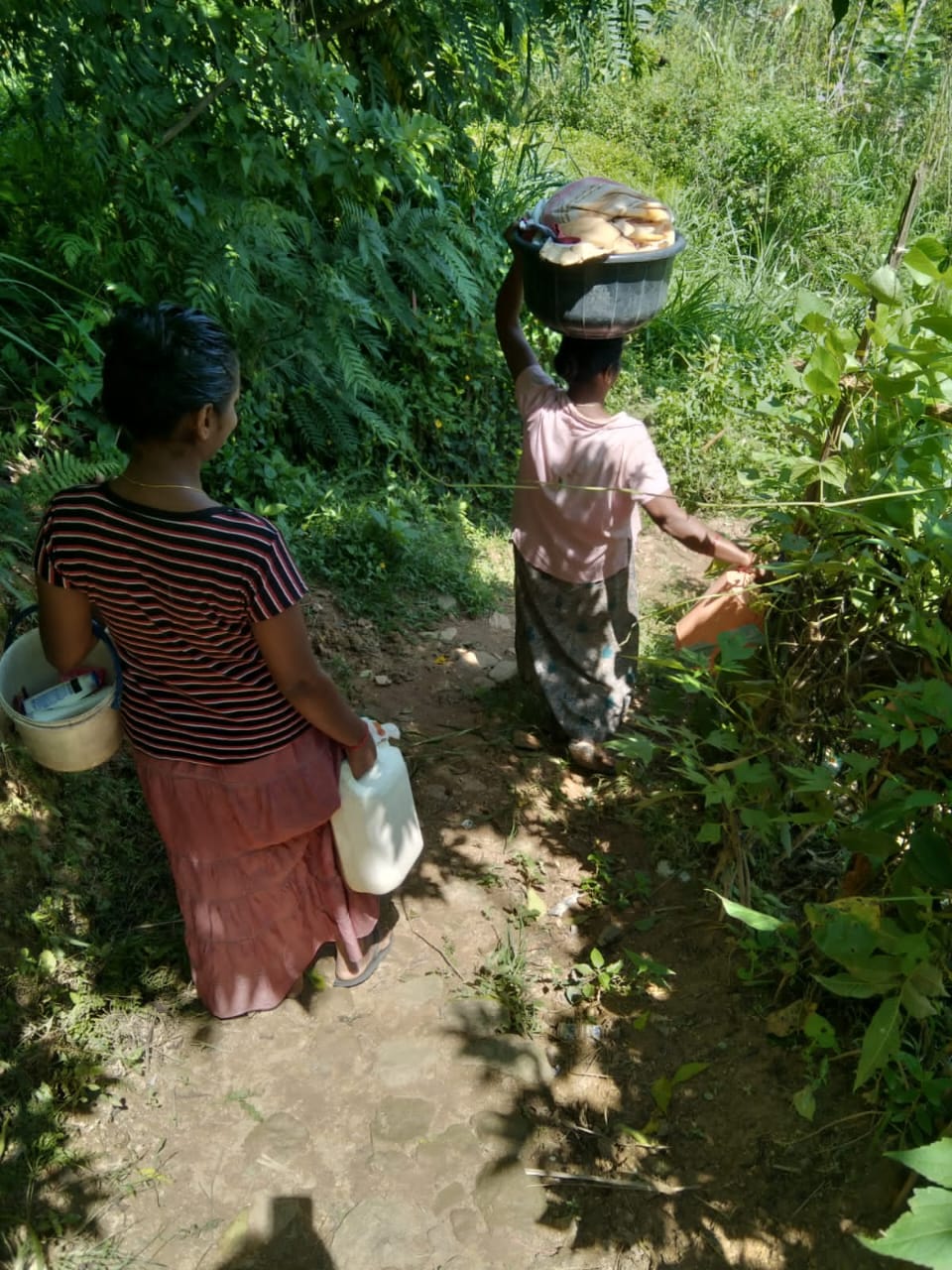The Daily Struggle for Water: The Story of Sarnia Estate, BadullaBy Piumi Ravindra -22.06.2023
A couple of women make their way down the slope towards the water source The SEVANATHA project team made their fourth visit to Sarnia Estate in Badulla to analyse the water source and distribution system in Mahatenna, a community cluster in Sarnia Estate. This field visit provided an opportunity to witness the community’s struggle to fulfil their daily water requirements. During the night, women walk to the natural spring and stream located at the lower elevation for bathing and washing after their day shift, which is a high-risk journey that exposes them to danger. What are the reasons for this issue? Let’s dig into some background information. Sri Lanka, being a tropical country, receives rain mainly during two monsoons: the southwest monsoon from May to September and the northeast monsoon from December to February. There is also some inter-monsoon rain, which contributes to enhancing natural water resources such as springs, streams, rivers, ponds and lakes. However, the availability of water for drinking, bathing, agriculture purposes etc. varies according to the specific terrain and climate zones. Rainfall in Sri Lanka has varied significantly over the last fifty years, with a record high of 2522.42 mm in 1963 and a record low of 1291.20 mm in 1980. Recently, it has increased from 1610.83 mm to 2038.73 mm from 2020 to 2021. Nevertheless, families living in rural areas, including hill country plantation communities, struggle to meet their daily water requirements. So, what is the reason behind the people’s struggle for water in Sarnia? Sarnia is a tea estate that was established in 1885 and is currently owned by the Malwatte Valley Plantation Company. It is spread over 165 hectares and has a total of 619 worker families. The primary water source for the community is a natural spring located in the Mahatenna mountain range. Water is delivered to individual families through multiple pipelines connected to a storage tank at the spring. The current situation of accessing water is explained by one of the residents of the Sarnia community. As she stated: "Water is a highly needed service for the Sarnia estate community, so groups of people from the Mahatenna division arranged a water supply from a well belonging to the Hindu Kovil. Water is pumped by a motor and distributed to public taps in the community. Each family pays LKR 300 per month to the Kovil for this service, and the estate and surrounding areas have rich water resources. Insufficient management of the water is the key reason for water scarcity in the community" Some said the water in the settlement is dirty. At the source, animal excrement has the potential to contaminate spring water. However, the majority of the residents in sub clusters of Mahatenna like ADB Quarters, Ottu Line, and Mettu Line receive water from the distribution lines that are improperly connected to the storage tank built close to the water source. Moreover, this storage tank was built about 15 years ago but is not functioning properly; no water is able to be stored there due to an improper way of fixing the distribution lines without any control valves. A twenty-three-year-old woman who lives in ADB Quarters emphasized that: "Twice a week, some of us climb up to the water source in Mahatenna through a foot path and bushes after 6 o’clock to connect the individual water lines that supply water to the ADB quarters where we live. During the rainy season, it is a real risk for women to walk up and down slopes in hill areas but due to the urgency of water for daily usage we have to undergo this difficulty." The baseline survey conducted in 2021 revealed that the main problem related to the current water supply in the estate is a lack of proper management of the system. Residents in the community stated that due to multiple connections to a single pipe line, and favoritism in water distribution influenced by some people, it resulted in an uneven distribution and an insufficient water supply for many families. Most of the time, water is supplied only for a short time, such as less than half an hour when the pipelines are connected to the source. For instance, ADB Quarters receive water for two hours only on Sundays, and eight families in Mettu Line obtain water for one-hour every other day. Residents use to collect and store water using cement tanks, jars, pots, or barrels, but this was not enough to meet their daily water needs. During the discussion with residents, it was brought up that they are extremely dissatisfied with the existing water supply system and its management as it is irregular and insufficient to meet their daily water needs. The current practice is ad-hoc and unreliable. In their view, the Mahatenna's natural spring has sufficient capacity if properly protected and stored, and the possibility of constructing deep wells and pumping water to storage tanks for distribution to families. The community has also suggested building a properly managed water supply system under the close supervision of the estate management. A key message from the Photovoice perspective workshop held in Sarnia in January 2023, was that the current water supply system should be improved through appropriate community interventions The main objective of such an intervention is to ensure that all families receive water, regardless of whether they currently have access to it or not. Solving the water-related challenges is a collective effort of many stakeholders that requires considerable time and resource input. Piumi Ravindra is Research Officer at the SEVANATHA Urban Resource Centre and a member of the Inclusive Urban Infrastructure (IUI) team. IUI is a project funded by UK Research and Innovation through the Global Challenges Research Fund under the title ‘Towards Trajectories of Inclusion: Making infrastructure work for the most marginalized’ (grant reference number ES/T008067/1). |



